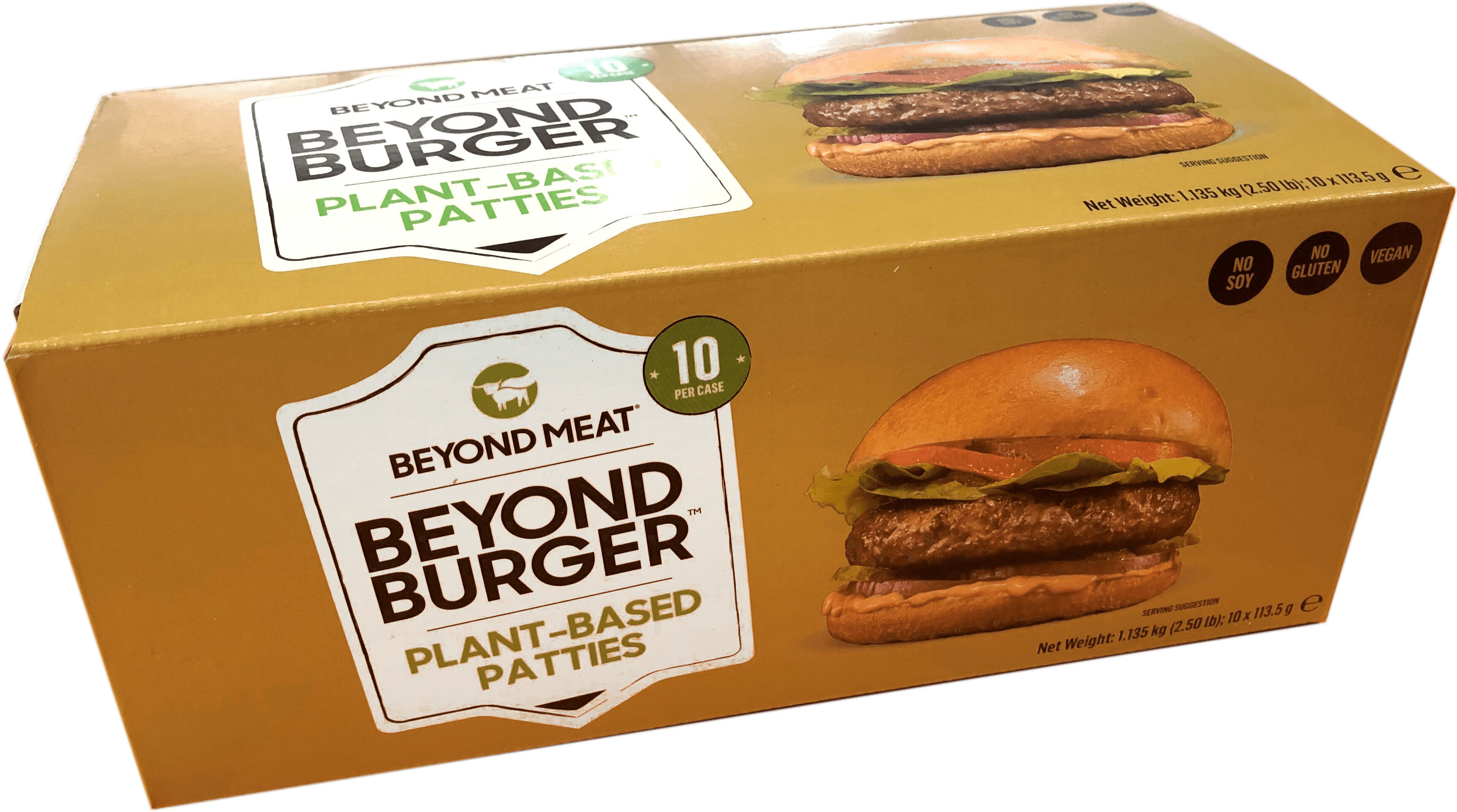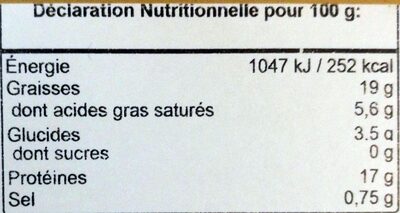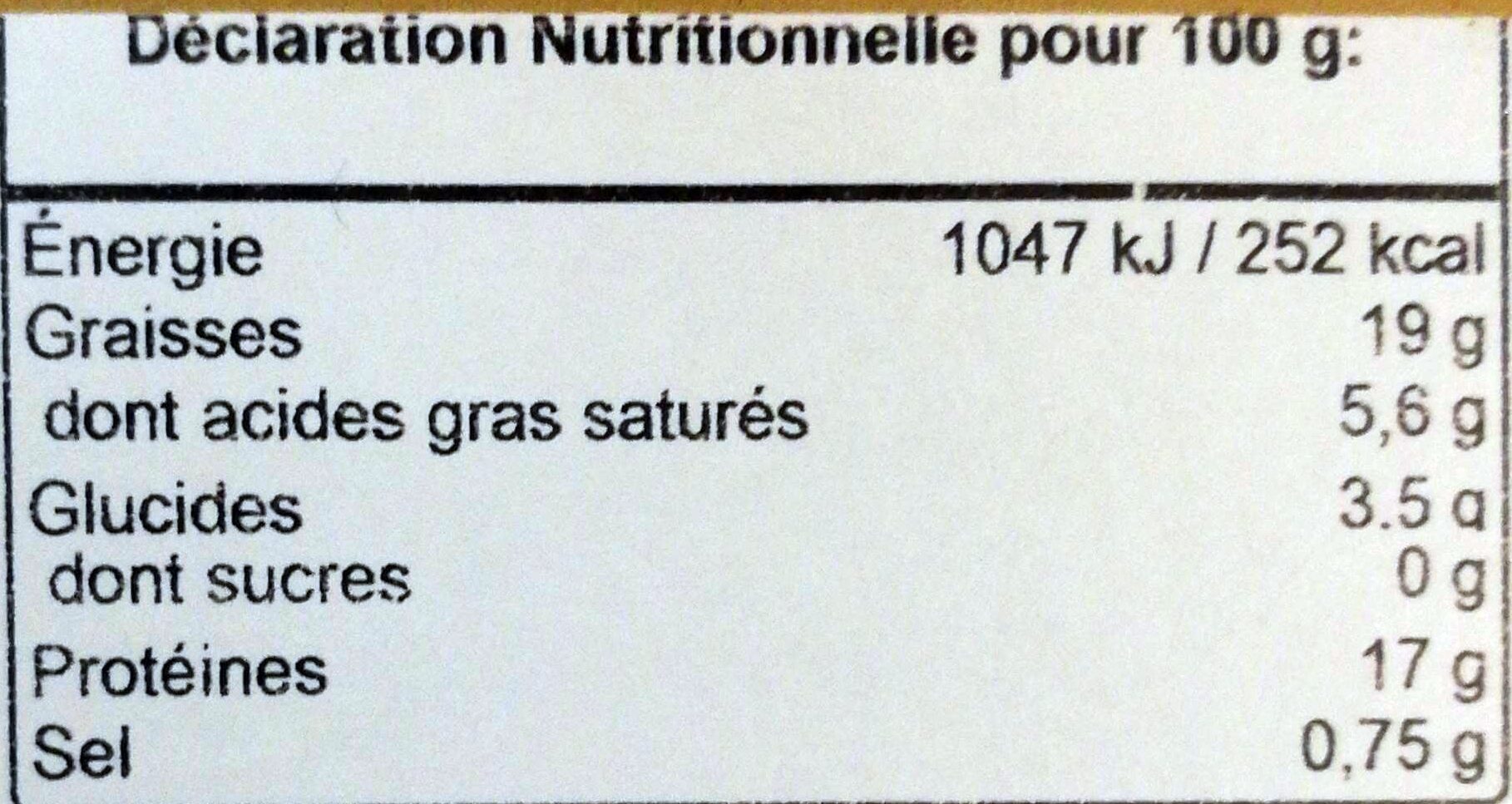Ajuda'ns a fer que la transparència alimentària sigui la norma!
Com a organització sense ànim de lucre, depenem de les vostres donacions per continuar informant els consumidors de tot el món sobre tot allò què mengen.
La revolució alimentària comença amb tu!
Beyond burger - Beyond Meat - 10 x 113,5g
Beyond burger - Beyond Meat - 10 x 113,5g
Aquesta pàgina del producte no està completa. Podeu ajudar a completar-la editant-la i afegint-hi més dades a partir de les fotos ja disponibles, o fent-ne més amb l'aplicació de androide o iPhone / iPad. Gràcies!
×
Codi de barres: 0850004207031 (EAN / EAN-13) 850004207031 (UPC / UPC-A)
Quantitat: 10 x 113,5g
Empaquetament: en:Card
Marques: Beyond Meat
Categories: Aliments i begudes amb base vegetal, Aliments amb base vegetal, en:Meat alternatives, Substitutius de carn, en:Vegetarian patties, en:Vegan patties
Etiquetes, certificacions, premis: Lliure de gluten, Vegetarià, Vegà, Lliure de soja, Amb oli de gira-sol
Enllaç a la pàgina del producte en el lloc oficial del productor: https://www.beyondmeat.com/products/the-...
Països on es va vendre: França, Alemanya, Països Baixos, Espanya
Matching with your preferences
Salut
Ingredients
-
24 ingredients
: Eau, isolat de protéine de pois (18%), huile de colza, huile de noix de coco raffinée, arôme, arôme de fumée, stabilisants: cellulose, méthylcellulose, gomme arabique; fécule de pomme de terre, maltodextrine, extrait de levure, sel, huile de tournesol, levure séchée, antioxydants acide ascorbique, acide acétique; colorant: rouge de betterave; amidon modifié, extrait de pomme, jus de citron concentré.
Processament d'aliments
-
Aliments ultra processats
Elements que indiquen que el producte està al grup 4 - Aliments i begudes ultraprocessats:
- Additiu: E14XX - Midó modificat
- Additiu: E162 - Betanina
- Additiu: E414 - Goma aràbiga
- Additiu: E460 - Cel·lulosa
- Additiu: E461 - Metilcel·lulosa
- Ingredient: Color
- Ingredient: Aromes
- Ingredient: Maltodextrina
Els productes alimentaris es classifiquen en 4 grups segons el seu grau de processament:
- Aliments no processats o mínimament processats
- Ingredients culinaris processats
- Aliments processats
- Aliments ultra processats
La determinació del grup es fa en funció de la categoria del producte i dels ingredients que conté.
Additius
-
E162 - Betanina
Betanin: Betanin, or Beetroot Red, is a red glycosidic food dye obtained from beets; its aglycone, obtained by hydrolyzing away the glucose molecule, is betanidin. As a food additive, its E number is E162. The color of betanin depends on pH; between four and five it is bright bluish-red, becoming blue-violet as the pH increases. Once the pH reaches alkaline levels betanin degrades by hydrolysis, resulting in a yellow-brown color. Betanin is a betalain pigment, together with isobetanin, probetanin, and neobetanin. Other pigments contained in beet are indicaxanthin and vulgaxanthins.Origen: Wikipedia (Anglès)
-
E260 - Àcid acètic
Acetic acid: Acetic acid , systematically named ethanoic acid , is a colorless liquid organic compound with the chemical formula CH3COOH -also written as CH3CO2H or C2H4O2-. When undiluted, it is sometimes called glacial acetic acid. Vinegar is no less than 4% acetic acid by volume, making acetic acid the main component of vinegar apart from water. Acetic acid has a distinctive sour taste and pungent smell. In addition to household vinegar, it is mainly produced as a precursor to polyvinyl acetate and cellulose acetate. It is classified as a weak acid since it only partially dissociates in solution, but concentrated acetic acid is corrosive and can attack the skin. Acetic acid is the second simplest carboxylic acid -after formic acid-. It consists of a methyl group attached to a carboxyl group. It is an important chemical reagent and industrial chemical, used primarily in the production of cellulose acetate for photographic film, polyvinyl acetate for wood glue, and synthetic fibres and fabrics. In households, diluted acetic acid is often used in descaling agents. In the food industry, acetic acid is controlled by the food additive code E260 as an acidity regulator and as a condiment. In biochemistry, the acetyl group, derived from acetic acid, is fundamental to all forms of life. When bound to coenzyme A, it is central to the metabolism of carbohydrates and fats. The global demand for acetic acid is about 6.5 million metric tons per year -Mt/a-, of which approximately 1.5 Mt/a is met by recycling; the remainder is manufactured from methanol. Vinegar is mostly dilute acetic acid, often produced by fermentation and subsequent oxidation of ethanol.Origen: Wikipedia (Anglès)
-
E414 - Goma aràbiga
Gum arabic: Gum arabic, also known as acacia gum, arabic gum, gum acacia, acacia, Senegal gum and Indian gum, and by other names, is a natural gum consisting of the hardened sap of various species of the acacia tree. Originally, gum arabic was collected from Acacia nilotica which was called the "gum arabic tree"; in the present day, gum arabic is collected from acacia species, predominantly Acacia senegal and Vachellia -Acacia- seyal; the term "gum arabic" does not indicate a particular botanical source. In a few cases so‐called "gum arabic" may not even have been collected from Acacia species, but may originate from Combretum, Albizia or some other genus. Producers harvest the gum commercially from wild trees, mostly in Sudan -80%- and throughout the Sahel, from Senegal to Somalia—though it is historically cultivated in Arabia and West Asia. Gum arabic is a complex mixture of glycoproteins and polysaccharides. It is the original source of the sugars arabinose and ribose, both of which were first discovered and isolated from it, and are named after it. Gum arabic is soluble in water. It is edible, and used primarily in the food industry as a stabilizer, with EU E number E414. Gum arabic is a key ingredient in traditional lithography and is used in printing, paint production, glue, cosmetics and various industrial applications, including viscosity control in inks and in textile industries, though less expensive materials compete with it for many of these roles. While gum arabic is now produced throughout the African Sahel, it is still harvested and used in the Middle East.Origen: Wikipedia (Anglès)
-
E460 - Cel·lulosa
Cellulose: Cellulose is an organic compound with the formula -C6H10O5-n, a polysaccharide consisting of a linear chain of several hundred to many thousands of β-1→4- linked D-glucose units. Cellulose is an important structural component of the primary cell wall of green plants, many forms of algae and the oomycetes. Some species of bacteria secrete it to form biofilms. Cellulose is the most abundant organic polymer on Earth. The cellulose content of cotton fiber is 90%, that of wood is 40–50%, and that of dried hemp is approximately 57%.Cellulose is mainly used to produce paperboard and paper. Smaller quantities are converted into a wide variety of derivative products such as cellophane and rayon. Conversion of cellulose from energy crops into biofuels such as cellulosic ethanol is under development as a renewable fuel source. Cellulose for industrial use is mainly obtained from wood pulp and cotton.Some animals, particularly ruminants and termites, can digest cellulose with the help of symbiotic micro-organisms that live in their guts, such as Trichonympha. In human nutrition, cellulose is a non-digestible constituent of insoluble dietary fiber, acting as a hydrophilic bulking agent for feces and potentially aiding in defecation.Origen: Wikipedia (Anglès)
-
E461 - Metilcel·lulosa
Methyl cellulose: Methyl cellulose -or methylcellulose- is a chemical compound derived from cellulose. It is a hydrophilic white powder in pure form and dissolves in cold -but not in hot- water, forming a clear viscous solution or gel. It is sold under a variety of trade names and is used as a thickener and emulsifier in various food and cosmetic products, and also as a treatment of constipation. Like cellulose, it is not digestible, not toxic, and not an allergen.Origen: Wikipedia (Anglès)
Anàlisi dels ingredients
-
No conté oli de palma
No s'han detectat ingredients que continguin oli de palma
-
Vegà
No s'han detectat ingredients no vegans
Ingredients no reconeguts: en:Apple extract
-
Vegetarià
No s'han detectat ingredients no vegetarians
Ingredients no reconeguts: en:Apple extract
-
Detalls de l'anàlisi dels ingredients
: Eau, isolat de protéine de pois 18%, huile de colza, huile de noix de coco raffinée, arôme, arôme de fumée, stabilisants (cellulose), méthylcellulose, gomme arabique, fécule de pomme de terre, maltodextrine, extrait de levure, sel, huile de tournesol, levure, antioxydants (acide ascorbique), acide acétique, colorant (rouge de betterave), amidon modifié, extrait de pomme, jus de citron concentré- Eau -> en:water - vegan: yes - vegetarian: yes - ciqual_food_code: 18066 - percent_min: 18 - percent_max: 82
- isolat de protéine de pois -> en:pea-protein-isolate - vegan: yes - vegetarian: yes - percent_min: 18 - percent: 18 - percent_max: 18
- huile de colza -> en:colza-oil - vegan: yes - vegetarian: yes - from_palm_oil: no - ciqual_food_code: 17130 - percent_min: 0 - percent_max: 18
- huile de noix de coco raffinée -> en:refined-coconut-oil - vegan: yes - vegetarian: yes - from_palm_oil: no - ciqual_food_code: 16040 - percent_min: 0 - percent_max: 18
- arôme -> en:flavouring - vegan: maybe - vegetarian: maybe - percent_min: 0 - percent_max: 5
- arôme de fumée -> en:smoke-flavouring - vegan: maybe - vegetarian: maybe - percent_min: 0 - percent_max: 5
- stabilisants -> en:stabiliser - percent_min: 0 - percent_max: 5
- cellulose -> en:e460 - vegan: yes - vegetarian: yes - percent_min: 0 - percent_max: 5
- méthylcellulose -> en:e461 - vegan: yes - vegetarian: yes - percent_min: 0 - percent_max: 5
- gomme arabique -> en:e414 - vegan: yes - vegetarian: yes - percent_min: 0 - percent_max: 5
- fécule de pomme de terre -> en:potato-starch - vegan: yes - vegetarian: yes - ciqual_proxy_food_code: 9510 - percent_min: 0 - percent_max: 5
- maltodextrine -> en:maltodextrin - vegan: yes - vegetarian: yes - percent_min: 0 - percent_max: 5
- extrait de levure -> en:yeast-extract - vegan: yes - vegetarian: yes - percent_min: 0 - percent_max: 5
- sel -> en:salt - vegan: yes - vegetarian: yes - ciqual_food_code: 11058 - percent_min: 0 - percent_max: 0.75
- huile de tournesol -> en:sunflower-oil - vegan: yes - vegetarian: yes - from_palm_oil: no - ciqual_food_code: 17440 - percent_min: 0 - percent_max: 0.75
- levure -> en:yeast - vegan: yes - vegetarian: yes - percent_min: 0 - percent_max: 0.75
- antioxydants -> en:antioxidant - percent_min: 0 - percent_max: 0.75
- acide ascorbique -> en:e300 - vegan: yes - vegetarian: yes - percent_min: 0 - percent_max: 0.75
- acide acétique -> en:e260 - vegan: yes - vegetarian: yes - percent_min: 0 - percent_max: 0.75
- colorant -> en:colour - percent_min: 0 - percent_max: 0.75
- rouge de betterave -> en:e162 - vegan: yes - vegetarian: yes - percent_min: 0 - percent_max: 0.75
- amidon modifié -> en:modified-starch - vegan: yes - vegetarian: yes - ciqual_proxy_food_code: 9510 - percent_min: 0 - percent_max: 0.75
- extrait de pomme -> en:apple-extract - percent_min: 0 - percent_max: 0.75
- jus de citron concentré -> en:concentrated-lemon-juice - vegan: yes - vegetarian: yes - ciqual_food_code: 2028 - percent_min: 0 - percent_max: 0.75
Nutrició
-
Poca qualitat nutricional
⚠ ️Atenció: la quantitat de fruita, verdura i fruits secs no s'especifica a l'etiqueta, s'ha fet una estimació a partir de la llista d'ingredients: 9Aquest producte no es considera una beguda per al càlcul de la Nutri-Score.
Punts positius: 0
- Proteïnes: 5 / 5 (valor: 17, valor arrodonit: 17)
- Fibra: 0 / 5 (valor: 0, valor arrodonit: 0)
- Fruites, verdures, fruits secs i olis de colza/nou/oliva: 0 / 5 (valor: 9.0009765625, valor arrodonit: 9)
Punts negatius: 11
- Energia: 3 / 10 (valor: 1047, valor arrodonit: 1047)
- Sucres: 0 / 10 (valor: 0, valor arrodonit: 0)
- Greixos saturats: 5 / 10 (valor: 5.6, valor arrodonit: 5.6)
- Sodi: 3 / 10 (valor: 300, valor arrodonit: 300)
Els punts per proteïnes no es compten perquè els punts negatius són més o iguals a 11.
Puntuació nutricional: (11 - 0)
Nutri-Score:
-
Nivells de nutrients
-
Greix en Quantitat moderada (19%)
Què us cal saber- Un alt consum de greixos, especialment de greixos saturats, pot augmentar el colesterol, que augmenta el risc de patir malalties del cor.
Recomanació: Reduïu el consum de greixos i greixos saturats- Trieu productes amb menys greixos i greixos saturats.
-
Àcid gras saturat en alta quantitat (5.6%)
Què us cal saber- Un alt consum de greixos, especialment de greixos saturats, pot augmentar el colesterol, que augmenta el risc de patir malalties del cor.
Recomanació: Reduïu el consum de greixos i greixos saturats- Trieu productes amb menys greixos i greixos saturats.
-
Sucre en baixa quantitat (0%)
Què us cal saber- Un alt consum de sucre pot provocar augment de pes i càries dental. També augmenta el risc de patir diabetis tipus 2 i malalties cardiovasculars.
Recomanació: Limitau el consum de sucre i de begudes ensucrades- Les begudes ensucrades (com ara refrescos, begudes de fruites i sucs i nèctars de fruites) s'han de limitar tant com sigui possible (no més d'1 got al dia).
- Triau productes amb menor contingut de sucre i reduïu el consum de productes amb sucres afegits.
-
Sal comuna en Quantitat moderada (0.75%)
Què us cal saber- Un alt consum de sal (o sodi) pot provocar un augment de la pressió arterial, que pot augmentar el risc de patir malalties del cor i ictus.
- Moltes persones que tenen hipertensió no ho saben, ja que sovint no en tenen símptomes.
- La majoria de la gent consumeix massa sal (de 9 a 12 grams de mitjana al dia), al voltant del doble del nivell màxim d'ingesta recomanat.
Recomanació: Limitau la ingesta de sal i d'aliments rics en sal- Reduïu la sal que emprau quan cuinau, i no afegiu sal a taula.
- Limiteu el consum d'aperitius salats i trieu productes amb menor contingut de sal.
-
-
Informació nutricional
Informació nutricional Com es ven
per 100 g/100 mlCom es ven
per porció (100g)Comparat amb: en:Vegan patties Energia 1.047 kj
(252 kcal)1.050 kj
(252 kcal)+25% Greix 19 g 19 g +81% Àcid gras saturat 5,6 g 5,6 g +130% Hidrats de carboni 3,5 g 3,5 g -63% Sucre 0 g 0 g -100% Fiber - - Proteïna 17 g 17 g +24% Sal comuna 0,75 g 0,75 g -32% Alcohol - - Fruits‚ vegetables‚ nuts and rapeseed‚ walnut and olive oils (estimate from ingredients list analysis) 9,001 % 9,001 %
Entorn
-
Eco-puntuació B - Impacte ambiental baix
El Eco-Score és una puntuació experimental que resumeix els impactes ambientals dels productes alimentaris.→ L'Eco-Score es va desenvolupar inicialment a França i s'està ampliant per a altres països europeus. La fórmula Eco-Score està subjecta a canvis, ja que es millora periòdicament per fer-la més precisa i més adequada per a cada país.Anàlisi del cicle de vida
-
Impacte mitjà dels productes de la mateixa categoria: A (Score: 81/100)
Categoria: Soy patty or vegetable escalope
Categoria: Soy patty or vegetable escalope
- Puntuació ambiental PEF ( petjada ambiental de l'aliment ): 0.27 (com més baixa sigui la puntuació, menor serà l'impacte)
- incloent l'impacte sobre el canvi climàtic: 1.75 kg CO₂ eq/kg del producte
Etapa Impacte Agricultura
22.6 %Processament
57.8 %Empaquetament
7.8 %Transport
7.3 %Distribució
0.0 %Consum
4.6 %
Bonificacions i punts negatius
-
Falta informació sobre l'origen dels ingredients
Punts negatius: -5
⚠ ️ L'origen dels ingredients d'aquest producte no està indicat.
Si estan indicats a l'embalatge, podeu modificar la fitxa del producte i afegir-los.
Si sou el fabricant d'aquest producte, podeu enviar-nos la informació amb la nostra plataforma gratuïta per a productors.
-
Falta informació sobre l'embalatge d'aquest producte
Punts negatius: -15
⚠ ️ La informació sobre l'embalatge d'aquest producte no està completada.⚠ ️ Per a un càlcul més precís de l'Eco-Score, podeu modificar la pàgina del producte i afegir-los.
Si sou el fabricant d'aquest producte, podeu enviar-nos la informació amb la nostra plataforma gratuïta per a productors.
Eco-Score per a aquest producte
-
Impacte per a aquest producte: B (Score: 61/100)
Producte: Beyond burger - Beyond Meat - 10 x 113,5g
Puntuació de l'anàlisi del cicle de vida: 81
Suma de bonificacions i punts negatius: -20
Puntuació final: 61/100
-
Petjada de carboni
-
Equivalent a conduir 0.9 km en un cotxe de gasolina
175 g de CO² per cada 100 g de producte
La xifra d'emissions de carboni prové de la base de dades Agribalyse d'ADEME, per a la categoria: Soy patty or vegetable escalope (Font: Base de dades ADEME Agribalyse)
Etapa Impacte Agricultura
21.5 %Processament
45.6 %Empaquetament
14.0 %Transport
13.8 %Distribució
0.0 %Consum
5.1 %
Empaquetament
-
Falta informació sobre l'embalatge d'aquest producte
⚠ ️ La informació sobre l'embalatge d'aquest producte no està completada.Take a photo of the recycling information Take a photo of the recycling information
Transport
-
Orígens dels ingredients
Falta informació sobre l'origen dels ingredients
⚠ ️ L'origen dels ingredients d'aquest producte no està indicat.
Si estan indicats a l'embalatge, podeu modificar la fitxa del producte i afegir-los.
Si sou el fabricant d'aquest producte, podeu enviar-nos la informació amb la nostra plataforma gratuïta per a productors.Add the origins of ingredients for this product Add the origins of ingredients for this product
Report a problem
-
Incomplete or incorrect information?
Category, labels, ingredients, allergens, nutritional information, photos etc.
If the information does not match the information on the packaging, please complete or correct it. Open Food Facts is a collaborative database, and every contribution is useful for all.
Fonts de dades
Producte afegit per waistline-app
Última modificació de la pàgina del producte per annelotte.
La pàgina del producte, també editada per acuario, aleene, arc2, daboue91, date-limite-app, elcoco, gourmet, kiliweb, neroc, openfoodfacts-contributors, prepperapp, roboto-app, scanbot, serandi, tacite-mass-editor, thaialagata, waistline.568495a9-734c-4984-8b47-b7ebe4320b2c, yuka.UzZ4Y0Z2VmNtUEFYd3NRQThSM0k4OHRMKzduNFdrNjJKY2NQSWc9PQ, yuka.Vko4QktJVTVyOEFyeXZjanBpdisydHhiL2FHcFhrcVpNL2d0SVE9PQ, yuka.WllZblFQNHpoNk1ydE0wNjJBajEydXN2N0krZ1lGcVBjN0FqSVE9PQ.











